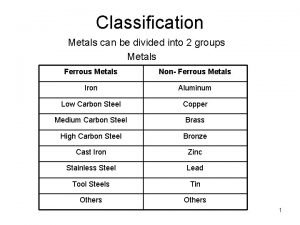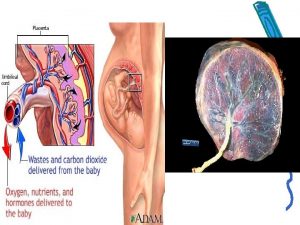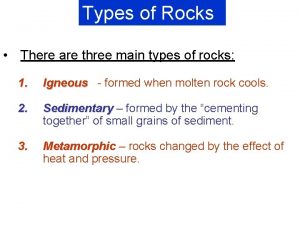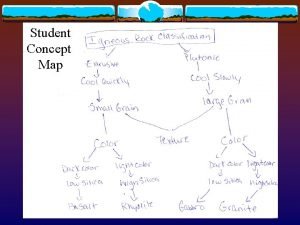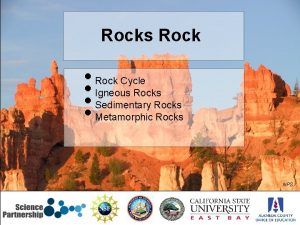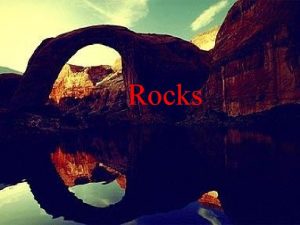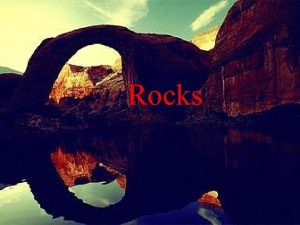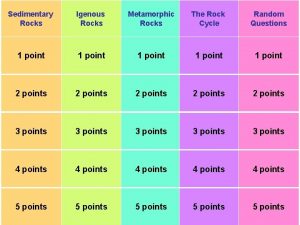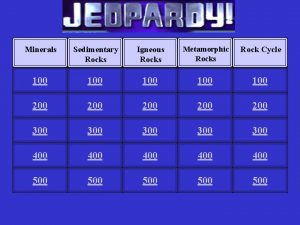Rock Classification Rocks are divided into three main















- Slides: 15

Rock Classification Rocks are divided into three main classes based on how they form: 1. Igneous 2. Sedimentary 3. Metamorphic Each type of rock can be further classified based on: n Composition and texture

Composition chemical make up of the rock or what it is made of. n The n This can be minerals or other materials: shells, clay, plants, sand, pebbles

Texture/Grains n Determined by the grains size, shape and position. n Igneous can be fine or coarse grain n Sedimentary can be characterized by observing lithified (cemented) inorganic grains, minerals, organic material, or fossil fragments. The wide range of textures common in sedimentary rocks is separated into clastic, chemical, and bioclastic (biochemical) groups.

Texture/Grains n. Metamorphic textures consist of two main types: foliated and non-foliated textures. n. Texture can reveal the process that formed the rock.

Igneous Rocks

What are they? n Rock made from cooled –LAVA, above ground or –MAGMA, below ground.

Classification They are classified in 3 ways: 1. Texture – Grain/ minerals 2. Origin - where formed 3. Mineral Composition – made from

Grain Size Have…. SPECIAL NAMES

Texture/Grain n Coarse Grained = large grains, cooled slowly Think about it…. If it cools over a long time – the grains have time to get big! Most abundant intrusive rock is GRANITE n Fine Grained = small grains, cooled fast Think about it… If it cools over a short time – the grains don’t have time to get big! Example: Basalt

Igneous Rock Formation-Origin n Extrusive – formed ABOVE GROUND. It cools fast so it has small grains. n Intrusive – formed UNDERGROUND. It cools slowly so it will have large grains. Laccolith

Examples of each type of ROCK Fine Grained Basalt = Extrusive Igneous rock Course Grained Granite = Intrusive Igneous rock

Mineral Composition n How much silica is in the magma/lava? – Low silica content = dark colored = Mafic – High silica content = light colored = Felsic High Silica Content Felsic Igneous Rock Low Silica Content Mafic Igneous Rock

Draw pictures of the different types of Igneous Rocks! Small or No Crystals Big Crystals Lighter Darker

Label the igneous rock formation

Ticket out: CHOOSE ONLY ONE What makes up the grains in an igneous rock? n. Illustrate grains of an igneous rock and explain why this happens n. Compare and contrast intrusive and extrusive igneous n
 Mikael ferm
Mikael ferm Rock cycle song (sedimentary igneous metamorphic)
Rock cycle song (sedimentary igneous metamorphic) Igneous metamorphic sedimentary
Igneous metamorphic sedimentary Get together theme
Get together theme Metals are divided into
Metals are divided into How can one type of rock change into another type of rock?
How can one type of rock change into another type of rock? How does igneous rock become metamorphic rock
How does igneous rock become metamorphic rock William wordsworth is known as a
William wordsworth is known as a Divided into three parts
Divided into three parts The eiffel tower is divided into three sections
The eiffel tower is divided into three sections Divided into three categories
Divided into three categories What are the three main types of
What are the three main types of Extrusive rocks
Extrusive rocks Rhyolite lame mince
Rhyolite lame mince Sedimentary rock concept map of rocks
Sedimentary rock concept map of rocks Concept map of major types of rocks
Concept map of major types of rocks




